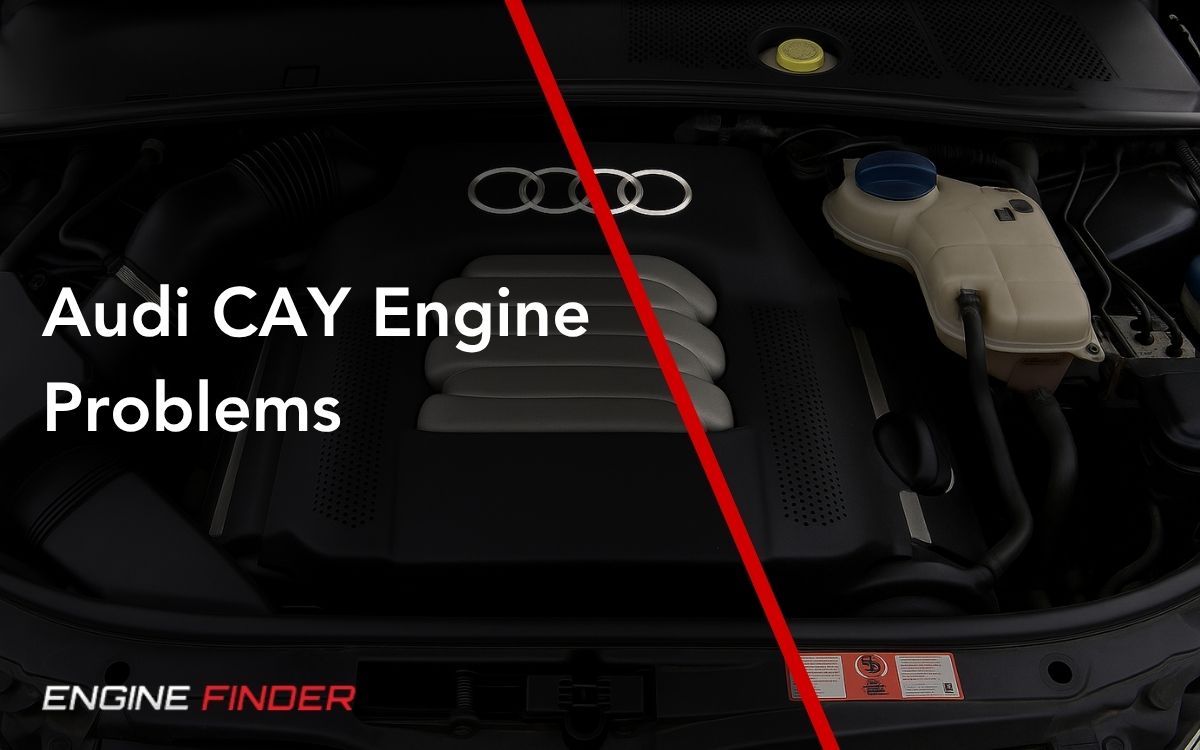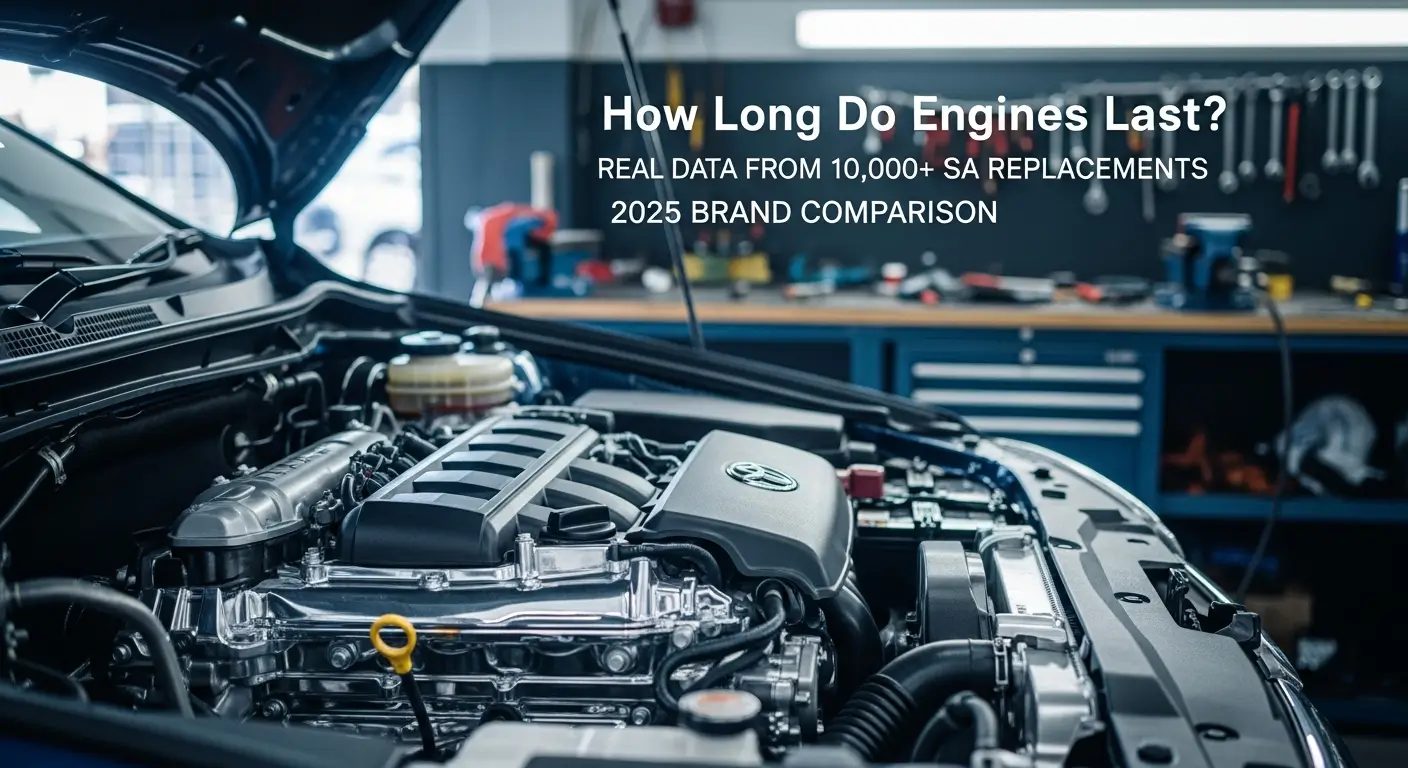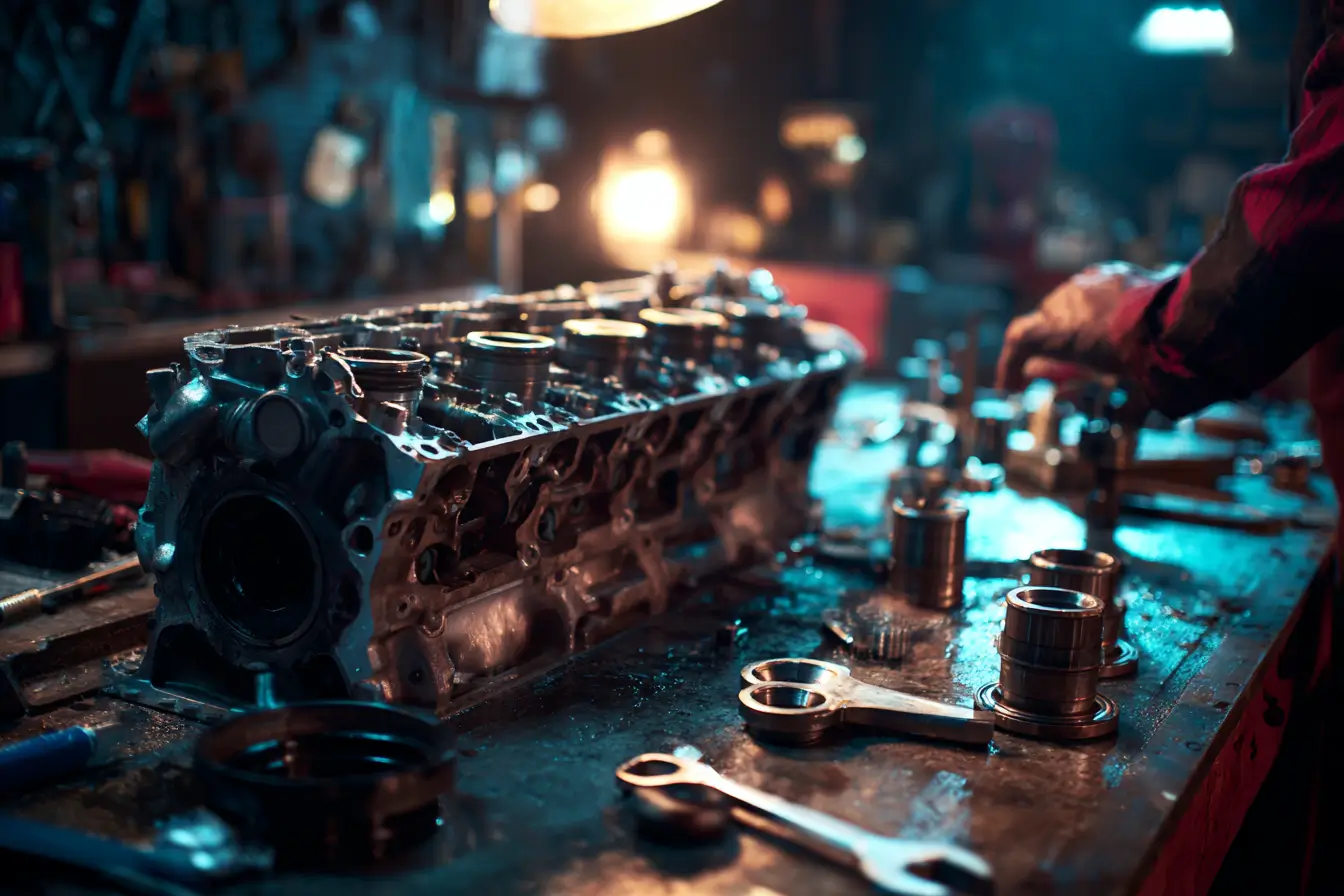
Common Audi CAY Engine Problems: Complete Diagnosis Guide
Key Takeaways
| Problem | Main Symptoms | Possible Causes |
|---|---|---|
| Fuel Injector Failure | Rough idle, knocking noise, black smoke | Carbon buildup, injector seal failure, high-pressure wear |
| EGR Valve Problems | Poor performance, engine warning lights | Carbon buildup, valve sticking, electrical failure |
| Oil Leaks | Oil spots under car, oil consumption | Valve cover gasket failure, seals deterioration |
| DPF Blockages | Reduced power, excessive smoke, warning lights | Short journeys, poor fuel quality, EGR contamination |
| Turbocharger Issues | Loss of power, whistling sounds | Oil contamination, bearing wear, actuator problems |
The Audi CAY engine family consists of 1.6-liter turbocharged diesel engines that belong to the EA189 family, commonly found in various VAG group vehicles from 2009-2015. The CAY designation encompasses multiple variants (CAYA, CAYB, CAYC, CAYD, CAYE) with different power outputs. The most common variant, CAYC, produces 105 hp and is primarily found in Audi A1 and A3 models. These common rail direct injection engines are known for good fuel economy but have developed several well-documented reliability issues that owners should understand.
CAY Engine Variants Overview
The CAY engine family includes several variants with different power outputs:
- CAYE: 75 hp (55 kW)
- CAYC: 105 hp (77 kW) - Most common, focus of this article
- CAYD: 102 hp (75 kW)
- CAYA/CAYB: Other variants with varying specifications
This article primarily focuses on the CAYC variant due to its widespread use in Audi vehicles.
Audi CAY Engine Specifications
| Specification | Details |
|---|---|
| Engine Code | CAY Family (CAYA, CAYB, CAYC, CAYD, CAYE) |
| Displacement | 1.6L (1,598cc) |
| Configuration | Inline-4, DOHC |
| Fuel System | Common Rail Direct Injection |
| Turbocharging | Single turbocharger with intercooler |
| Power Output | 75-105 hp (varies by variant) |
| CAYC Variant | 77 kW (105 hp) - Most Common |
| Torque | 250 Nm @ 1,500-2,500 RPM (CAYC) |
| Production Years | 2009-2015 |
| Primary Applications | Audi A1, A3 8P (CAYC confirmed) |
1. Fuel Injector Failure
Causes
- Carbon buildup on injector nozzles from direct injection design
- High-pressure fuel system wear over extended use
- Poor quality diesel fuel causing internal contamination
- Injector seal deterioration leading to combustion pressure loss
- Continental injector stretch bolt problems in EA189 engines
Symptoms
- Rough idle and engine misfiring at idle
- Metallic knocking noise from affected cylinder
- Black smoke from exhaust during acceleration
- Reduced fuel economy and power output
- Engine warning lights and fault codes
- Difficulty starting, especially when cold
Solution
- Replace faulty fuel injectors with genuine parts
- Replace injector stretch bolts and copper seals
- Clean fuel system and replace fuel filter
- Perform injector coding with diagnostic equipment
- Use high-quality diesel fuel with cleaning additives
DIY Difficulty / Hours
- Professional repair recommended: High difficulty / 5-7 hours
- Cost: R6,000-R12,000 per injector including labor
Important Warning
EA189 engines are particularly susceptible to injector problems due to Continental injector design issues. Always replace stretch bolts when changing injectors to prevent combustion pressure loss.
2. EGR Valve Problems
Causes
- Carbon buildup from exhaust gas recirculation
- EGR valve sticking in open or closed position
- Electrical actuator failure
- Poor maintenance allowing excessive soot accumulation
- Vacuum line leaks affecting valve operation
Symptoms
- Engine performance reduction and sluggish acceleration
- Engine warning lights with P0403 error codes
- Rough idle and unstable engine operation
- Increased fuel consumption
- Black smoke from exhaust
- Engine going into limp mode
Solution
- Clean EGR valve and intake manifold thoroughly
- Replace EGR valve if cleaning doesn’t resolve issues
- Check and repair vacuum lines
- Update engine management software if available
- Regular maintenance to prevent carbon buildup
DIY Difficulty / Hours
- EGR cleaning: Medium difficulty / 2-3 hours
- EGR replacement: Medium-high difficulty / 3-4 hours
- Cost: R1,500-R3,000 for cleaning, R4,000-R8,000 for replacement
Prevention Tip
Regular highway driving helps burn off carbon deposits in the EGR system. Consider using EGR cleaning additives every 20,000 km to maintain proper operation.
3. Oil Leaks
Causes
- Valve cover gasket deterioration due to heat cycles
- Crankshaft and camshaft seal wear
- Oil cooler seal failure
- High oil pressure causing seal failures
- Poor quality aftermarket seals
Symptoms
- Oil spots under parked vehicle
- Oil visible on engine exterior
- Increased oil consumption between services
- Burning oil smell from engine bay
- Low oil level warnings
Solution
- Replace valve cover gasket and associated seals
- Replace crankshaft and camshaft seals if leaking
- Use genuine Audi parts for all seal replacements
- Check oil pressure for abnormally high readings
- Clean engine thoroughly after repair
DIY Difficulty / Hours
- Valve cover gasket: Medium difficulty / 3-4 hours
- Crankshaft seals: High difficulty / 6-8 hours
- Cost: R2,000-R4,000 for valve cover, R4,000-R8,000 for major seals
Maintenance Note
Oil leaks are particularly common in CAY engines due to the valve cover design. Early intervention prevents more expensive repairs and engine damage.
4. DPF Blockages
Causes
- Predominantly short-distance driving preventing regeneration
- Poor quality diesel fuel with high sulfur content
- EGR system contamination increasing soot production
- Failed injectors causing excessive particulate matter
- Faulty DPF pressure sensors
Symptoms
- Reduced engine power and acceleration
- DPF warning lights on dashboard
- Excessive black smoke from exhaust
- Engine going into limp mode
- Increased fuel consumption
- Strong diesel smell from exhaust
Solution
- Perform forced DPF regeneration using diagnostic equipment
- Clean DPF filter professionally or replace if severely blocked
- Address underlying causes (EGR, injectors)
- Use high-quality diesel fuel and regular highway driving
- Replace DPF pressure sensors if faulty
DIY Difficulty / Hours
- DPF regeneration: Professional only / 1-2 hours
- DPF replacement: Professional only / 4-6 hours
- Cost: R3,000-R6,000 for regeneration, R20,000-R30,000 for replacement
Critical Warning
Never ignore DPF warnings as complete blockage can cause severe engine damage. The 1.6 TDI CAY engine family (particularly the CAYC variant) is particularly sensitive to DPF problems due to its emissions system design.
5. Turbocharger Issues
Causes
- Oil contamination from failed seals or poor maintenance
- Carbon buildup in variable geometry mechanism
- Turbo bearing wear from excessive heat cycles
- Oil feed line blockages causing oil starvation
- Actuator failure affecting boost control
Symptoms
- Loss of power and slow acceleration
- Whistling or whining sounds from engine bay
- Blue smoke from exhaust indicating oil burning
- Turbo actuator error codes
- Boost pressure irregularities
Solution
- Replace turbocharger with reconditioned or new unit
- Clean oil feed and return lines thoroughly
- Replace intercooler if oil contaminated
- Address root causes to prevent recurrence
- Update software for actuator control if available
DIY Difficulty / Hours
- Professional repair only: Very high difficulty / 6-8 hours
- Cost: R15,000-R25,000 for reconditioned turbo including labor
Important Note
The CAY engine’s turbocharger is more reliable than larger TDI engines but still requires proper maintenance. Regular oil changes are critical for turbo longevity.
Preventative Maintenance Tips
Regular Service Schedule
| Service Type | Interval | Components |
|---|---|---|
| Oil Change | 10,000 km | Engine oil, filter |
| Fuel Filter | 20,000 km | Fuel filter, water separator |
| EGR Service | 40,000 km | EGR cleaning, intake cleaning |
| Major Service | 40,000 km | All filters, fluids, inspection |
Critical Maintenance Items
- Quality Oil: Use VW 507.00 specification oil only
- Regular Highway Driving: Essential for DPF and EGR system health
- Fuel Quality: Use premium diesel from reputable suppliers
- Early Problem Detection: Address warning lights immediately
- Injector Service: Consider professional injector cleaning every 80,000 km
Conclusion
The Audi CAY engine, while offering excellent fuel economy and adequate performance, requires diligent maintenance to prevent costly failures. The most critical issues - injector problems, EGR valve maintenance, and oil leak prevention - can be largely managed through proper servicing and quality parts. When problems do occur, early diagnosis and professional repair are essential to prevent cascade failures.
For South African owners facing major repairs, finding quality Audi engines for sale or professional Audi stripping for spares services can provide cost-effective alternatives to expensive dealer repairs.
FAQ
How often should I service my Audi CAY engine?
Follow the 10,000 km oil change interval strictly, with major services every 40,000 km. For predominantly city driving, consider 7,500 km oil changes to protect the DPF and turbocharger.
What type of oil should I use in the CAY engine?
Use only engine oil meeting VW 507.00 specification. Recommended brands include Castrol Edge Professional, Mobil 1 ESP, or genuine Audi oil. Never use incorrect specifications.
How can I prevent injector problems?
Use high-quality diesel fuel, replace fuel filters on schedule, and consider professional injector cleaning every 80,000 km. Address any rough running immediately.
Is the CAY engine reliable compared to other TDI engines?
The CAY engine is generally more reliable than larger TDI engines due to lower stress levels, but it shares common EA189 family issues like injector problems and DPF sensitivity.
What should I do if my EGR valve fails?
Replace the EGR valve with a genuine part and have the intake manifold cleaned professionally. Consider software updates that may improve EGR system operation.
References and Further Reading
Technical Resources
Maintenance Guides
Video Resources
Related Articles
Explore more insights on similar topics

How Long Do Engines Last on Average? Complete Longevity Guide
Understand real-world engine lifespan ranges, warning signs, lifecycle stages, costs, and maintenance best practices for South African drivers.

How Does an Engine Overhaul Work? Complete Guide to Engine Rebuilds
Learn everything about engine overhauls: types, warning signs, process, costs, and when to rebuild vs replace your engine in South Africa.
.webp)
Timing Chain vs Timing Belt: Complete Guide to Cambelt Replacement & Lifespan
Learn everything about timing chains and timing belts (cambelts): differences, lifespans, replacement costs, and which is better for your engine in South Africa.
Important Disclaimer
This content is for informational purposes only and is based on research from automotive industry sources. Engine Finder is not a certified automotive repair facility. Always consult with qualified automotive professionals before performing any repairs or maintenance. Improper repairs can result in personal injury, property damage, or vehicle malfunction. We assume no responsibility for actions taken based on this information.
